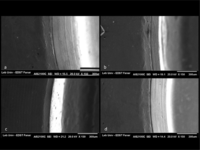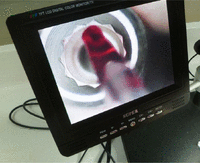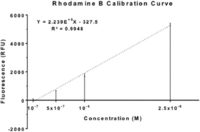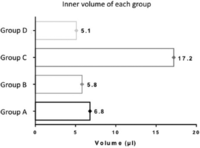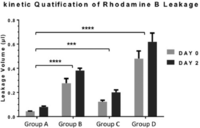Leakage evaluation of original and compatible implant–abutment connections: In vitro study using Rhodamine B
- 1School of Dentistry, Lebanese University, Beirut, Lebanon
- 2Ecole Doctorale, PRASE, Lebanese University, Beirut, Lebanon
- Antoine Berberi, Department of Oral and Maxillofacial Surgery, School of Dentistry, Lebanese University, Hazmieh, Main Damas Main Road, PO Box 5208-116, Beirut, Lebanon. Email: anberberi@gmail.com
Abstract
Leakage has been addressed as a major contributing factor to inflammatory reactions at the implant–abutment connection, leading to problems such as oral malodor, inflammation, and marginal bone loss. The aim of this study was to investigate in vitro the leakage at implant–abutment interface of OsseoSpeed™ implants connected to original and compatible abutments. A total of 28 OsseoSpeed implants were divided into four groups (n = 7). Each group was connected to four different abutments according to manufacturers’ recommendations: group A (TiDesign™); group B (Natea™); group C (Dual™); and group D (Implanet™) abutments. The inner volume of each implant–abutment combination was calculated and leakage was detected for each group with spectrophotometric analysis at 1 h (D0) and 48 h (D1) of incubation time using Rhodamine B. At 1 h, leakage volume was significantly lower in TiDesign and Dual than in Natea and Implanet (P < 0.001). At 48 h, however, leakage was significantly lower between TiDesign and all other systems (P < 0.005). Compatible abutments do not fit internal connection of OsseoSpeed implants perfectly, which increases the leakage of the final assembly.
- Dental implants
- abutment connection
- implant–abutment interface
- leakage
- Rhodamine B
- compatible abutment
Introduction
Most dental implant systems consist of two components: the implant that is placed during the first surgical phase, and the abutment that is later screwed onto the implant to support the prosthetic restoration. These implant systems present gaps and cavities between implant, abutment, and screw that can act as a trap for bacteria causing inflammatory reactions in the peri-implant soft tissues and bone.1⇓⇓⇓–5 During the prosthetic phase, bacterial dissemination inside the implant body is nearly unavoidable,6⇓⇓–9 and since the implant–abutment connection (IAC) is located near alveolar bone crest, microbial colonization of this area may result in marginal bone loss (MBL) and could also be one of the factors responsible for the 1-mm bone loss observed during the year following functional loading.1,2,7,10⇓⇓⇓–14
Microbial leakage is an important factor in chronic inflammatory infiltration,2,3,10 as increase in inflammatory cell content in areas close to IAC has been attributed to adhesion and proliferation of bacteria at this level during prosthetic components installation and soft tissue manipulation.1⇓–3,11,13,15⇓–17 Several investigators attempted to quantify microbial leakage of dental implants using bacterial leakage,4,7,15,18⇓⇓⇓⇓⇓⇓⇓⇓–27 endotoxins,28⇓–30 color markers,31 and gas flow.32,33 Rhodamine B (RhB) is an interesting marker since it is highly soluble in water (~50 g/L) and reacts with photogenerated oxyradicals. Furthermore, RhB fluoresces when exposed to 535-nm wavelength light and can thus be easily detected using spectrophotometry.34⇓–36 Different volumes of suspension have also been used to inoculate implants in micro-leakage studies ranging from 0.3 to 5 µL.4,15,24,27,28,31 Furthermore, the volume inside the implant body designed to host the abutment and screw is specific to each implant systems and for a specific solution.37
Reducing overheads in the dental office or in the dental laboratory may lead to adopting alternative solutions involving the use of non-original or compatible abutments (i.e. abutments produced by a different manufacturer). However, the design of abutment joints is hence carefully matched with implant connection because biomechanical properties depend on factors such as materials, tolerance, connection design, and preload.38⇓⇓⇓⇓⇓–44
The aim of this study was to test the leakage of OsseoSpeed™ implants with original and compatible abutments in vitro. The null hypothesis of the present study was that there is no difference in leakage when using original or compatible abutments.
Material and methods
Implant and abutments
A total of 28 OsseoSpeed implants (5 mm × 11 mm, Astra Tech Implant System™; Dentsply Implants, Mölndal, Sweden) were used in this study. The samples were divided into four groups (n = 7; Table 1)
Group combination with implants and abutments size, type.
In group A, seven implants were connected to original TiDesign™ abutments (5.5 mm × 1.5 mm, Astra Tech Implant System, Dentsply Implants); in group B, they were connected to Natea™ abutments (5.8 mm × 2 mm; Euroteknika™ Groupe, Sallanches, France); in group C, they were connected to Dual™ abutments (5.5 mm × 1.5 mm; Implantium, Dentium Implant System, Seoul, South Korea); and in group D, they were connected to Implanet™ abutments (5.5 mm × 1.5 mm, Derig LTDA, Sao Paulo, Brazil) (Figure 1).
Leakage evaluation
An RhB 10−2 M solution was prepared by dissolving 0.1 g of RhB (Sigma R 6626-25G) in 20 mL of distilled water placed into 50-mL falcon tubes. To accurately quantify the amount of leakage in the four groups, a calibration curve was drawn using four concentrations of RhB (10−7, 5 × 10−7, 10−6, and 2.5 × 10−6). In all our experiments, we used a wavelength-monitoring mode of the Vision Collect™ (Thermo Fisher, Pittsburgh, PA, USA) software to acquire the exact absorbance spectra. The RhB solution was transferred by mean of a single-channel micropipette (L322606, Pipetman; Gilson Service, Villiers Le Bel, France) using one new ultra-thin tip for each manipulation (1310A, 236; Ranin, Dallas, USA). For each concentration, fluorescence was acquired in a previously calibrated spectrophotometer (Fluorescence Spectrophotometer; Hitachi, Tokyo, Japan) with a special cuvette (Perkin Elmer Luminescence Spectroscopy Cells Part No B0631104).
Handling of the implants and abutments
To avoid any contamination, all implants, abutments, screwdrivers, torque controller, and other instruments used in the experiment were sterilized inside surgical bags prior to test procedure, in an autoclave class B at 121°C, at 1 kg/cm2 of pressure for 30 min (W&H Lisa Sterilizers, Sydenham, Christchurch, New Zealand). All RhB traces were removed after each manipulation; implants, abutments, and screws were placed in 15-mL vials and cleaned four times with ethanol 70% and three times with distilled water in a vortex machine (Wisd Vortex Mixer; Daihan Scientific Co., Seoul, South Korea) and then sterilized in autoclave.45,46
Kinetic quantification of leakage
After determination of the inner volume of all implants as described in the pilot study,37 kinetic quantification of leakage was evaluated for each implant by adding 0.1 µL to the inner volume value previously determined. A controlled automated pipette (L322606, Pipetman) using ultra-thin tips (1310A, 236; Ranin), one for each implant–abutment combination, was used to place the corresponding volume of RhB solution inside the implants (Figure 2), and the abutment was secured according to each manufacturer’s recommendations using a vise-bench to hold the implants in position. The connected implant–abutment was placed into 15-mL falcon tubes previously filled with 2 mL of distilled water. Vials were protected from light and placed on a shaker for 48 h for a homogenous distribution of RhB in the water (GFL 3005; Gesellschaft fur Labortechnik mbH, Burgwedel, Germany). For each group, spectrophotometric analysis was performed with a spectrophotometer (Fluorescence Spectrophotometer; Hitachi) with a special cuvette (Perkin Elmer Luminescence Spectroscopy Cells Part No B0631104) at 1 and 48 h of incubation time at room temperature. Of the 2 mL of distilled water, 1 mL was collected from vials at each time to perform spectrophotometric analysis. It is noteworthy that the implant–abutment set was submerged in the water during incubation time, due to the conical form of the vial. Fluorescence present in the water and measured by fluorimetry indicated (by use of the calibration curve) the concentration of RhB in water. Knowing the concentration and the volume placed in the IAC, the volume of leakage of RhB that leaked from the implant–abutment assembly to the water medium was calculated using the following formula: Initial Concentration × Initial Volume = Final Concentration × Final Volume.47
Statistical analysis
The data were collected and statistically analyzed using GraphPad Prism® 6 (GraphPad Software, Inc., La Jolla, CA, USA). One-way analysis of variance (ANOVA) was used, and statistical significance was set at 0.05.
Results
The calibration curve absorbance was linear with respect to the RhB amount in distilled water, presenting a R2 of 0.9948 (Figure 3). At 1 and 48 h, respectively, leakage volume and percentage of each combination were as follows: group A—0.043 µL or 1.48% (standard deviation (SD) = 0.0022 µL), 0.08 µL or 5.56% (SD = 0.0074 µL); group B—0.276 µL or 27.92% (SD = 0.0382 µL), 0.38 µL or 39.80% (SD = 0.0192 µL); group C—0.123 µL or 10.59% (SD = 0.0116 µL), 0.20µL or 19.31% (SD = 0.0193 µL); and group D—0.48 µL or 51.03% (SD = 0.0625 µL), 0.619 µL or 66.71% (SD = 0.0725 µL).
Calibration curve was determined by linear regression considering the fluorescence (R2 = 0.9948).
There was a significant difference between the systems since the calculated P values were between 0.001 and 0.0001. SDs were also very low (between 0.0792 and 0.0022) signing the accuracy of the measurement technique. Results are summarized in Tables 2 and 3.
Mean and standard deviation (SD) of the leakage volumes for each system at D0 and D1 (P < 0.05).
Percentage of leakage of each group at D0 and D1 with percentages of fold increase.
Discussion
The results of the current experiment led to the rejection of the null hypothesis tested, as there was a significant difference in leakage between compatible and original abutments. Reducing MBL in implant therapy is a challenging process, and maintaining it over time can be an equally demanding task. Marginal bone preservation is subject to both mechanical38⇓⇓–41,48⇓⇓–51 and microbiological aspects of the IAC.2,7,10,12,52,53 Assessment of leakage in vitro is one of the characteristics that may be correlated to clinical performance of the implant system, and it is one of the factors that should be taken into consideration when selecting components for an implant system.
Microbiological studies are very sensitive in handling, and biological agents are susceptible to changes in the working area. RhB was used as a tracing dye to measure exact leaked volumes based on its concentration in the solution. Use of RhB is advantageous because of the small molecular size and weight (479.01 g/mol, 40 kDa).54 The gap size at the IAC of Astra Tech Implant System was measured and varies between 1 and 2 µm.7 RhB proved to be able to pass through gaps more quickly than endotoxin (50–100 kDa)55 and bacteria (1.1–1.5 µm).28 These findings may explain why a higher rate of leakage and faster increase of RhB fluorescence were observed in comparison to the leakage rates detected using microbiological studies.
The first step was to create a standard curve where we could perform a statistically significant fitting showing a linear correlation between concentrations ranging from 0 to 2.5 × 10−6 and the relative fluorescence of RhB. Inner volume results were determined as 17.2 µL for group C, 6.8 µL for group A, and 5.8 and 5.1 µL, respectively, for groups B and D (Figure 4). Leakage results showed a wide variation between the combinations probably due to the difference between the design of the internal connection of OsseoSpeed implants and the conical design of the compatible abutments (Figure 5).
At D0 and D1, the leakage volume of each system is shown. According to the Prism convention of significance, results were considered highly significant: ***P ≤ 0.001; ****P ≤ 0.0001.
The inner volumes have no effect on the leakage. Leakage is affected by the accuracy of the components production and fabrication and the resulting gap between abutments and implants.
The choice of 1 and 48 h was made after trying different time points, and the period of 48 h was sufficient to show the full kinetic evolution of leakage, since most of the leakage took place during the first 48 h, and the measurement of the fluorescence after 7 days did not show any significant changes in the results. This is in accordance with other observations.28,56
When the combination OsseoSpeed–TiDesign is considered as a control, OsseoSpeed–Implanet presents 1113% and 782%, while OsseoSpeed–Natea presents 640% and 481% fold increase at 1 and 48 h, respectively, while OsseoSpeed–Dual presents 286% and 253% for the same period. This is considered a significant increase that first supports the idea that majority of the leak happens in the first few hours, and most importantly, it shows the compactness or firmness of Astra Tech Implant System combination compared to the compatible components.
Lang et al.57 showed in an in vitro study that computer-aided design (CAD)/computer-aided manufacturing (CAM) generated non-original abutments; the original screw heads did not fit into the abutment heads. Alves da Cunha et al.58 observed in an in vitro test that the degree of misfit between original abutments and original implants was approximately 50% of that observed with compatible abutments. Gigandet et al. proved that the rotational misfit of a non-original abutment was higher compared to the original abutments of Straumann implants system. Also, they revealed that the combination of grooves and surfaces was completely different between original and non-original abutments.44
In daily practice, dental technicians and practitioners often select compatible abutments for financial reasons. Compatible components differ in the design of connecting surfaces, shape, dimensions, and material and have showed higher leakage values. The differences in design are possibly related to patent issues that do not allow exact replication of components and/or related to the precision level and the quality control of materials used during the manufacturing process.
Conclusion
Within the limitations of this in vitro study, the use of compatible abutment components with original Astra Tech implants showed significant leakage when compared to the use of abutment and implant from same manufacturer. Further studies are still required to validate these studies to other systems and assess the differences after simulated clinical function.
Acknowledgments
The authors would like to thank Prof. Ziad Salameh, Dr Hani Ounsi, Prof. Nabil El Zein, and Dr Ziad Noujeim for their valuable contribution to the study.
Article Notes
-
Declaration of conflicting interests The authors declare that they have no conflict of interest and do not have any financial interest in the products or information listed in this article.
-
Funding This project was supported by a grant from the Doctoral School, Lebanese University.
- Received March 5, 2014.
- Accepted July 10, 2014.
- © The Author(s) 2014
This article is distributed under the terms of the Creative Commons Attribution-NonCommercial 3.0 License (http://www.creativecommons.org/licenses/by-nc/3.0/) which permits non-commercial use, reproduction and distribution of the work without further permission provided the original work is attributed as specified on the SAGE and Open Access page (http://www.uk.sagepub.com/aboutus/openaccess.htm).

